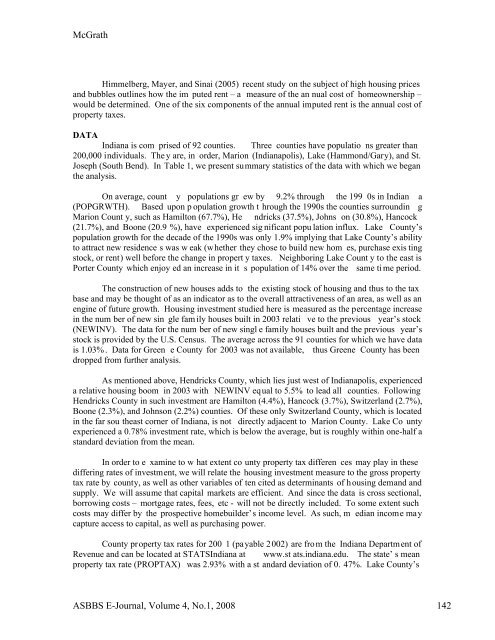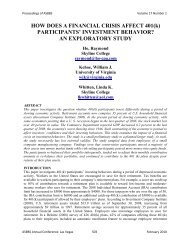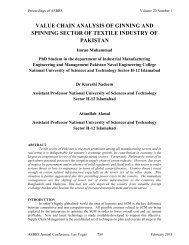stock repurchase announcements: a test of market ... - Asbbs.org
stock repurchase announcements: a test of market ... - Asbbs.org
stock repurchase announcements: a test of market ... - Asbbs.org
Create successful ePaper yourself
Turn your PDF publications into a flip-book with our unique Google optimized e-Paper software.
McGrath<br />
Himmelberg, Mayer, and Sinai (2005) recent study on the subject <strong>of</strong> high housing prices<br />
and bubbles outlines how the im puted rent – a measure <strong>of</strong> the an nual cost <strong>of</strong> homeownership –<br />
would be determined. One <strong>of</strong> the six components <strong>of</strong> the annual imputed rent is the annual cost <strong>of</strong><br />
property taxes.<br />
DATA<br />
Indiana is com prised <strong>of</strong> 92 counties. Three counties have populatio ns greater than<br />
200,000 individuals. The y are, in order, Marion (Indianapolis), Lake (Hammond/Gary), and St.<br />
Joseph (South Bend). In Table 1, we present summary statistics <strong>of</strong> the data with which we began<br />
the analysis.<br />
On average, count y populations gr ew by 9.2% through the 199 0s in Indian a<br />
(POPGRWTH). Based upon p opulation growth t hrough the 1990s the counties surroundin g<br />
Marion Count y, such as Hamilton (67.7%), He ndricks (37.5%), Johns on (30.8%), Hancock<br />
(21.7%), and Boone (20.9 %), have experienced sig nificant popu lation influx. Lake County’s<br />
population growth for the decade <strong>of</strong> the 1990s was only 1.9% implying that Lake County’s ability<br />
to attract new residence s was w eak (whether they chose to build new hom es, purchase exis ting<br />
<strong>stock</strong>, or rent) well before the change in propert y taxes. Neighboring Lake Count y to the east is<br />
Porter County which enjoy ed an increase in it s population <strong>of</strong> 14% over the same ti me period.<br />
The construction <strong>of</strong> new houses adds to the existing <strong>stock</strong> <strong>of</strong> housing and thus to the tax<br />
base and may be thought <strong>of</strong> as an indicator as to the overall attractiveness <strong>of</strong> an area, as well as an<br />
engine <strong>of</strong> future growth. Housing investment studied here is measured as the percentage increase<br />
in the num ber <strong>of</strong> new sin gle fam ily houses built in 2003 relati ve to the previous year’s <strong>stock</strong><br />
(NEWINV). The data for the num ber <strong>of</strong> new singl e family houses built and the previous year’s<br />
<strong>stock</strong> is provided by the U.S. Census. The average across the 91 counties for which we have data<br />
is 1.03% . Data for Green e County for 2003 was not available, thus Greene County has been<br />
dropped from further analysis.<br />
As mentioned above, Hendricks County, which lies just west <strong>of</strong> Indianapolis, experienced<br />
a relative housing boom in 2003 with NEWINV equal to 5.5% to lead all counties. Following<br />
Hendricks County in such investment are Hamilton (4.4%), Hancock (3.7%), Switzerland (2.7%),<br />
Boone (2.3%), and Johnson (2.2%) counties. Of these only Switzerland County, which is located<br />
in the far sou theast corner <strong>of</strong> Indiana, is not directly adjacent to Marion County. Lake Co unty<br />
experienced a 0.78% investment rate, which is below the average, but is roughly within one-half a<br />
standard deviation from the mean.<br />
In order to e xamine to w hat extent co unty property tax differen ces may play in these<br />
differing rates <strong>of</strong> investment, we will relate the housing investment measure to the gross property<br />
tax rate by county, as well as other variables <strong>of</strong> ten cited as determinants <strong>of</strong> housing demand and<br />
supply. We will assume that capital <strong>market</strong>s are efficient. And since the data is cross sectional,<br />
borrowing costs – mortgage rates, fees, etc - will not be directly included. To some extent such<br />
costs may differ by the prospective homebuilder’s income level. As such, m edian income may<br />
capture access to capital, as well as purchasing power.<br />
County property tax rates for 200 1 (payable 2002) are from the Indiana Department <strong>of</strong><br />
Revenue and can be located at STATSIndiana at www.st ats.indiana.edu. The state’ s mean<br />
property tax rate (PROPTAX) was 2.93% with a st andard deviation <strong>of</strong> 0. 47%. Lake County’s<br />
ASBBS E-Journal, Volume 4, No.1, 2008 142

















